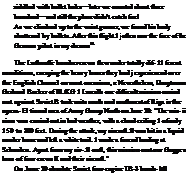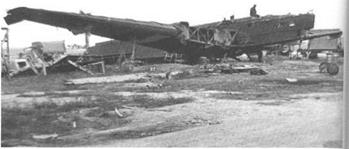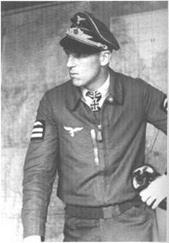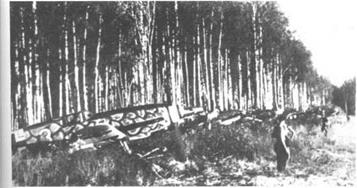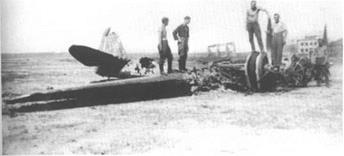That Day I Will Remember to the End. of My Life”
|
I |
n accordance with the Blitzkrieg doctrine, Hitler’s invasion of the Soviet Union on June 22, 1941, opened with a massive air assault against the Soviet air-base system all along the 1,000-mile front. The first major task assigned to the Luftwaffe was to relieve the invasion army from any threat from the air.
Luftwaffe veterans, hardened in the savage battles over France and the English Channel, delivered the first strike against the air-base system of the Soviet Air Force in the early hours of Sunday, June 22, 1941. During the night of June 21-22, about 150 German bombers— Do 17s of KG 2, Ju 88s of KG 3, and He Ills of KG 53-started crossing the border into the USSR from the Baltic Sea to the Black Sea. This was the scouting force, comprised of crews who were experienced in night flight. Divided into elements of three to five planes, they headed for all the main Soviet military air bases within the border region. As the scouts buzzed across the dark and silent East European sky, thousands of aircraft engines roared to life on Luftwaffe airfields in East Prussia, Poland, and Romania. This was a display of German precision at its peak.
The first raid was carried out a few minutes ahead of schedule, against the home of 15 IAP/8 SAD based at Alytus Airdrome, halfway between the East Prussian border and the city of Vilnius. Conducted by the Bf 110s of 5th Staffel of ZG 26, this attack was led by a cousin of the famous “Red Baron,” Hauptmann Johannes Freiherr von Richthofen.1
At about 0305 hours, the pathfinder force started reaching its targets. In an instant, incendiary bombs provided a beacon to thirty-one Soviet airfields.
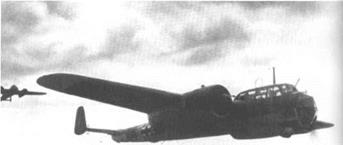
Despite previous warnings, the massive Luftwaffe onslaught against the Soviet aviation installations in the western border area during the early hours of Sunday, June 22, 1941, caught most Soviet airfields by a total surprise. The Do 17 "high-speed bombers" of KG 2 flew against airfields and communication lines in the border area between Soviet-occupied eastern Poland and Lithuania throughout the first day of war and managed to escape with only one Do 17 lost. Shown on this photo is the Do 111-2, the most common bomber version of the Do 17. The slim aerodynamic fuselage of trie Do 17 rendered it the nickname “Flying Pencil”. (Photo: Bundesarchiv.)
Minutes later, the Luftwaffe’s first attack wave—870 medium bombers, Stukas, Zerstorer, and fighter-bombers—hit their targets. The timing for the attack could not have been better chosen. The Luftwaffe struck just as the reequipment program of the VVS stood at its height. Due to teething problems with the new aircraft types entering service, the front-line airfields—many of them fewer than ten miles from the border—were packed with aircraft, both old types on their way out, and the newly received modern types. This was particularly the case in the recently Soviet-occupied territories of Lithuania and eastern Poland, where the airfield construction program simply had not complied with the need to harbor such vast numbers of aircraft.
An astonishing sight met the German airmen as they approached their targets. On most Soviet airfields hit by the Luftwaffe, the Soviet airplanes stood parked in tight row’s, wingtip to wingtip, and with no camouflage measures whatsoever.
To several German airmen, the first raid was merely a gunnery training exercise. The units of Luftflotte 1, under the command of Generaloberst Alfred Keller, were directed against the WS installations in Lithuania, where Hauptmann Johannes von Richthofen had already opened the onslaught. Hauptmann Gerhard Baeker, the techni
cal officer of III./KG 1 Hindenburg, told the authors: “At 0211 we took off on our first mission against the East. It was a clear night and the horizon was bright from the midnight sun in the far north. Our target was the airfield Libau in Lithuania. The base was occupied by a fighter unit, and its so-called Ratas stood parked in nice, tight rows, offering us a good target in the bright night.”
The Ju 88s of 1I1./KG 1 unloaded their bombs onto “long rows of completely uncamouflaged aircraft standing in close formation as though on parade along the edges of the Libau (Liepaja) airfield,” as stated by another of the participants in that raid, Hauptmann Manfred von Cossart." Hauptmann Baeker adds, “We landed undramatically at 0351, before sunrise.”
Major Hannes Trautloft escorted other Ju 88s of Luftflotte 1 against the Kaunas Airdrome in Lithuania at the head of his JG 54. Just as the bombers came in over the large, grass-covered airfield, the sun rose above the horizon and cast its bright rays on the deadly birds. Trautloft watched as the fragmentation bombs exploded in devastating series among the double lines of neatly parked Soviet aircraft. Here, dozens of 1-153s of 13ІАР/ 8 SAD were turned into scrap within minutes. Only two airborne 1-153s appeared in front of the attacking air-
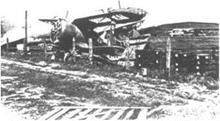

 |
I craft, but they left as quickly as they came. Returning 1 from this raid, the Luftwaffe air crews reported seventy К Soviet planes put out of commission.
At the airfield of Varena, southwest of Vilnius in I the old Polish-Lithuanian border area, 8./JG 53 shot up В seven of the SB bombers of 54 SBAP/57 SAD on the j ground. 111./JG 53 was subordinate to Fliegerkorps VIII, J commanded by General Wolfram
■ Freiherr von Richthofen, Johannes von
■ Richthofen’s elder brother. General von К Richthofen was one of the Luftwaffe’s J; most able close-support commanders.
|: Indeed the Luftwaffe’s fearsome Blitz-
j krieg tactic was due mainly to him.
The two Fliegerkorps of General – I к feldmarschall Albert Kesselring’s power – i S ful Luftflotte 2, to the south of Luftflotte I 1, were in action against all VVS units ; that could possibly threaten the German ]: Army Group Center. Operating in the
1 і skies over the left flank of this army В group. General von Richthofen directed j j his Fliegerkorps VIII mainly against 11 and 9 SAD of the Red Army’s Western 11- Special Military District (ZOVO).
At Grodno Airdrome, a few miles } from the northern part of the Soviet – I I German Polish border, a formation of M6s of 122 LAP/11 SAD attempted to I take off as a formation of Bf 109s came
swooping down. The fragmentation bombs fell upon the starting planes, and they were all destroyed in a perfect take-off formation at the end of the runway. Mladshiy Leytenant Sergey Dolgushin, one of the Soviet pilots, later described how it looked from the side of the attacked: “At three o’clock, the alarm went off. We all ran towards our airplanes. At 0420, when the
Messerschmitts appeared over the airfield, 1 had to take off. While 1 was taking off, during that first dogfight, l was hit sixteen times.”3
Of the seventy-five 1-16 fighter planes in 122 IAP, sixty-five were destroyed.
9 SAD/ZOVO, based in the Bialystok area only a few miles from the attack forces of the German Panzergruppe 3, northeast of Warsaw, suffered even worse. This composite aviation division was a crack unit commanded by the Hero of the Soviet Union General – Mayor Sergey Chernykh, a veteran from the aerial combats in the Spanish Civil War, where he had shot down three Loyalist planes (including the first Bf 109 ever to be lost in air combat). According to an inspection shortly before the outbreak of the war, General-Mayor Chernykh’s command was one of the best in the entire VVS. The four fighter regiments in 9 SAD were equipped w ith 233 of the modern MiG-3 fighters and had only 156 obsolete Polikarpov fighters. The division’s bomber regiment, 13 SBAP, was equipped with fifty-one bombers, including twenty-two experimental tw’in-engine Ar-2 dive-bombers (a modified version of the SB “highspeed bomber”).
9 SAD had the dubious luck of receiving the attention of both Fliegerkorps VIII and II of Luftflotte 2, and suffered heavier losses that any other VVS unit on this fateful Sunday morning. All of 9 SAD’s airfields were targeted. In his diary, Leutnant Arnold Doring, an He 111 pilot in KG 53 Legion Condor of Fliegerkorps II, described the first raid against the airfield of 1261АР/ 9 SAD at Dolubovo, south of Bialystok:
The ground below is covered with haze, but the targets nevertheless are clearly visible. 1 am surprised that we are not met w’ith any counteraction. This will come as some surprise to those below!
The “eggs” are released. Piles of fire and smoke, fountains of earth and dust, mixed with wreckage parts of all kinds, are shooting vertically upward. Unfortunately our bomb rows lay to the right side of the ammunition bunkers. But a whole row of bombs goes down across the entire field and plows the runway. The take-off strip receives two hits.
As the formation makes a turn 1 can see fifteen of the parked fighters go up in flames, plus most of the living quarters. Toni cries: “Antiaircraft fire,” but we could only see one single shot more than
half a mile behind us. We are already out of their shooting range. Then there is a fearsome cry over | the radio: “Fighters from behind!” Our machine guns rattle. The formation tightens up. Of course, a we offer a large target to the Russians, but our и defensive fire is most concentrated. Bullet tracers, j from twenty-seven planes sprinkle against the Russians, who immediately decide to disappear j diving.4
General Bruno Loerzer’s Fliegerkorps П, to which KG 53 belonged, struck against 9 and 10 SAD on the right wing of Army Group Center in the Soviet-German : border district of Poland. Making six low-level attacks against Pinsk Airdrome in the southwestern part of the Soviet-occupied Polish territories, a single Ju 88 piloted by Leutnant Ernst-Wilhelm Ihrig, the commander of 3./KG 3 Blitz, claimed sixty planes destroyed on the ground. Here, 39 SBAP/10 SAD lost forty-three SB bombers and five Pe-2s. At Brest Airdrome, close to the Soviet-German border in Poland, 33 IAP/10 SAD had twenty fighters destroyed by Bf 109 fighter-bombers dut – S ing the first raid. During another raid against the same target, nine Bf 109s pressed home their strafing attacks for nearly 40 minutes and put an additional twenty-one I-16s and five l-153s out of action.
One Staffel, l./SKG 210, equipped with Bf 110s, destroyed about fifty of 10 SAD’s aircraft at Kobrin, 30 miles farther to the east, where the headquarters of 10 SAD and the Soviet Fourth Army were located. In all, 10 SAD lost 180 of 231 planes on June 22. Two of 10 SADs air regiments were completely wiped out. SKG 210 was reported to have destroyed no fewer than 344 planes on the ground and claimed an additional eight in the air on this day.
The situation looked much the same immediately to the south of the Pripyat Marshes, where Generaloberst; Alexander Lohr’s medium bombers and Bf 109 strafers of Luftflotte 4 struck against twenty-nine Soviet airfields over a wide area all the way down to the Black Sea coast.
VVS-Kiev Special Military District (KOVO), on the northern flank of this area, received the full brunt of the attacks by KG 51, KG 54, KG 55, and JG 3 of Fliegerkorps V. Hauptmann Hans von Hahn, flying a Bf 109 at the head of 1./JG 3, wrote in his diary: “We hardly believed our eyes. Row after row of reconnaissance planes, bombers, and fighters stood lined up as if on parade.”
Launching eighty Ju 88s on the first mission of the day, KG 51 was reported to have destroyed about a hundred of KOVO’s aircraft on the ground. “That day 1 will remember to the end of my life,” says Fyodor Arkhipenko, mladshiy leytenant and operations duty officer of 17 1AP in Kovel in northwestern Ukraine. He recalls:
Beginning at 0425 in the morning, about fifty German planes bombed our field, coming back four times. Only myself and the duty pilot, my squadron leader, Ibragimov, and the guards, the security forces, were there. Because it was Sunday, the rest had been allowed to go home on leave.
The airfield was small, two by three kilometers. You can imagine the kinds of horrors that took place at the airfield. Then, by afternoon, the pilots and ground crews started arriving. Many of them, their hair had turned white. And some of them had even begun to stutter from fear after experiencing that kind of bombing.3
Starshiy Leytenant Aron Shapiro of 86 SBAP, based at Ternopol, about a hundred miles farther to the south, still has a vivid memory of the bombings by KG 51 on this Sunday morning:
Since the commanders of the Polk had left for a staff meeting on Saturday, 1 was the senior officer on the airfield. The alarm went off at 0400 hours.
No one understood what happened. At about 0430, three planes appeared. They looked very similar to our SBs. We watched silently as they approached at high speed at an altitude of 300 feet. Everyone believed that our commanders had ordered these planes to undertake a mock attack in order to test our combat vigilance.
As they buzzed above our heads, we suddenly saw that they didn’t carry red stars—but black crosses—under their wings! And then we heard bomb explosions. We didn’t know what to do. The connection to the headquarters was severed. In the control tower there was a radio transmitter.
1 managed to handle it, and from the very noisy conversations that I heard, l understood that war had broken out. Then we only heard German voices in the radio.
Ten minutes after the first bombing, more alien aircraft appeared. By that time, we understood that
|
|
Fyodor Arkhipenko experienced the attack by Fliegerkorps V against the air base at Kovel on June 22, 1941, as a nineteen-year-old mladshiy leytenant in 17 IAP. Arkhipenko would survive to pay the Germans back by amassing a total thirty individual and fourteen shared aerial victories. In 1945, Arkhipenko was recognized as a Hero of the Soviet Union, In this post-war photo Arkhipenko wears the Golden Star, the token of a Hero of the Soviet Union, and the medal Tor the Victory over Fascist Germany.” (Photo: Seidl.)
they were German. We opened fire at them with everything that could shoot, but since we had no antiaircraft artillery, we could only confront the Germans with light arms fire, including rifles. The aircraft gunners sat in the turrets of the bombers and fired vertically.
One of the German bombers was hit and left a black trail of smoke. 1 think it was a Ju 88. The crew bailed out and landed on our airfield. Everyone rushed to the point of descent and surrounded them. One officer who knew German served as interpreter. 1 particularly remember one of the Germans, a huge, red-haired young man. He acted most brazenly. “Stalin kaputt, Heil Hitler he acclaimed, smiling scornfully. We had no
intention of playing his game. A soldier gave him two punches, which made the German pilot more talkative. Finally we found out what was going on. It was war-the Blitzkrieg had started. He confidently declared that the Germans would be in Moscow’ by October: “To all of you, allcs kaputt!”
The Soviet reaction to the first German onslaught was sporadic and uncoordinated, to which came the confusion created by communications lines broken down as a result of the air raids.
Only the commander of the air force of Odessa Military District had ordered ordered his commsand to w-ar readiness and dispersed his units and aircraft over several airfields. As a result, only six aircraft under his command were destroyed on the ground. But this was the only exception.
Oberleutnant Georg Schirmbdck, who participated in JG 77’s first fighter-bomber mission against the airfields of VVS of the Soviet Black Sea Fleet (ChF), later told German aviation historian Jochen Prien: “Russia
really was not prepared at all. Railway stations, villages, | everywhere where there was light, the entire country I was lit up. At railway stations we could see fully normal ] activity.”
Leutnant Joachim Deicke of JG 77 recalls the scene 1 as the German fighter-bombers came buzzing dow n against I their target: “The Russians came out of their barracks | and waved their hands at us. Having seen this, upon the j return to our base, we asked ourselves if this raid wasn’t ] a terrible mistake.”’’
 |
While the bombs were raining over dozens of Soviet 1 airfields, the huge invasion army crossed the Soviet borders along a 500-mile front ranging from the Baltic coast | in the north and across the entire Soviet-German border in Poland. Stukas, ground-attack planes, and Bf 109 and | Bf 1І0 strafers flew over the heads of the advancing 1 German soldiers, striking defense positions, command | posts, and troop quarters of the Red Army. The Soviet border troops were caught totally by surprise, and at most places the entire front crumbled.
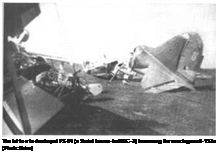
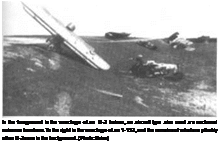 The scene on the Soviet side was characterized by total confusion. “From beleaguered command posts, field telephone-centers, and bomb-ravaged aerodromes, messages poured into Moscow: We are under fire. What are we meant to do?’ Back came the reply: ‘You must be feeling unwell. And why isn’t your message in code?’”7 This reply from the High Command perfectly reflects the Stalinist mentality of appeasement at this time: “Do not give in to provocation! Do not open fire!” According to Soviet Marshal Aleksandr Vasilevskiy, the Red Army had received strict orders to avoid “any action that the Nazi leaders could use to exacerbate the
The scene on the Soviet side was characterized by total confusion. “From beleaguered command posts, field telephone-centers, and bomb-ravaged aerodromes, messages poured into Moscow: We are under fire. What are we meant to do?’ Back came the reply: ‘You must be feeling unwell. And why isn’t your message in code?’”7 This reply from the High Command perfectly reflects the Stalinist mentality of appeasement at this time: “Do not give in to provocation! Do not open fire!” According to Soviet Marshal Aleksandr Vasilevskiy, the Red Army had received strict orders to avoid “any action that the Nazi leaders could use to exacerbate the
situation or make a military1 provocation.” The Soviet leaders desperately clung to the hope that the German attack was an act of “self-willing German generals” attempting to provoke a war against the will of Stalin’s ally Hitler.
Vitse-Admiral Filipp Oktyabrskiy, the commander of the ChF, received the answer from Moscow that Sevastopol simply was not under attack—hardly reassuring to the admiral as bombs began exploding outside the building from which he was making the call.
In the northern Baltic area, Mladshiy Leytenant Nikolay Gapeyonok, an SB pilot in 202 SBAP, had an experience quite symptomatic of the general confusion during these hours, at an airfield fifteen miles north of Kingisepp. Gapeyonok told the authors: “No one had expected war. It broke out on a Sunday. On the previous day, Saturday, most of the regiment’s airmen had left for athletic games. 1 was one of the few who remained on duty’ at the airfield. Suddenly we could hear sirens, but we expected it was training. Since the radio operator was gone, we couldn’t receive any radio calls. It was not until 1100 hours, as the airmen returned to the airfield, that we learned that there was war. Fortunately, our airfield was not bombed."
Despite the surprise attack and spotty communications, Soviet pilots scrambled at several places. Bitter dogfights raged in the skies all along the front during these early morning hours. The Soviet fighter pilots, in fact, managed surprisingly well on this first day.
At Kurovitsa Airdrome, to the south of Lvov in the northwestern Ukraine, units of VVS-KOVO had been alerted before the German bombers had reached this target. Nevertheless, the pilots of the ground-attack regiment 66 ShAP figured it was a training alarm and came too late-which resulted in thirty-four of the regiment’s 1-153 Chaykas and I-15bis being scrapped by the Ju 88s of KG 51.
As the bombs fell, the fighter pilots of 164 LAP were
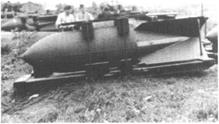

 airborne and climbed from Kurovitsa after the enemy in their small I-16s. Minutes later, they were followed by the remaining biplanes of 66 ShAP. “Skillful and aggressive attacks by Russian fighter units,” the chronicle of KG 51 comments, “ensured that the struggle for air supremacy was no easy game.”8
airborne and climbed from Kurovitsa after the enemy in their small I-16s. Minutes later, they were followed by the remaining biplanes of 66 ShAP. “Skillful and aggressive attacks by Russian fighter units,” the chronicle of KG 51 comments, “ensured that the struggle for air supremacy was no easy game.”8
Leytenant P. N. Rubstov of 66 ShAP attacked a formation of German bombers. He sprayed a Ju 88 with machine-gun bullets until it finally caught fire and crashed within sight of Kurovitsa Airdrome. Thus Leytenant Rubstov probably achieved the first aerial victory in the Russo-German war.
The Polikarpov fighters kept pursuing the Junkers bombers of KG 51 on their return flight to the west In minutes, one bomber after another was shot down. The Germans left a trail of white parachutes and blazing flames in the hazy sky. Of twenty-eight Ju 88s dispatched by 1II./KG 51, seven were shot down during this first mission, five of them from 9th Staffel.
In the middle of all this, the German fighter escort appeared. The fast Bf 109s
of JG 3 jumped the Soviets with hammering cannons and machine guns. The first 1-16 was shot down by Oberleutnant Robert Oljenik of l./JG 3. As it buried itself into the ground, Oljenik had achieved his sixth of forty-one confirmed victories in World War II. His was prob ably the first German aerial kill in the Russo-German war. At 0430, Feldwebel Ernst Heesen of 2./JG 3 destroyed a second Ishak. As it went down, the glow from the raging fires at Kurovitsa .Airdrome, twenty miles farther to the east, could still be seen in the darkness. A third 1-16 fell victim to Feldwebel Detlev Luth of l./JG 3.
KG 55 Greif (Griffon) had at least eight He 11 Is shot down by fighters and five damaged while attacking the airfields of VVS-KOVO. Returning from their bombing mission against Dubno Airdrome at about 0425, the crews of 1./ KG 55 experienced the determination with which many Soviet airmen fought. The He 111 of 3./KG 55 piloted by Unteroffizier Werner Bahringer came under attack from a lone 1-16. The Soviet fighter pilot, Leytenant Ivan Ivanov of 46 1AP, had no intention of letting this intruder get away; he simply crashed his small Ishak fighter right into Unteroffizier Bahringer’s He 111 in the air fifteen miles east of Dubno. Both planes went down.
The bomber violently burst into flames as it hit the ground. Apart from the gunner, who was probably killed as Ivanov’s 1-16 rammed the bomber, the crew of the Heinkel managed to bail out, but they were all reported missing, probably captured by the Soviet troops and killed. Leytenant Ivanov never got out of his fighter; he was later found dead among the dispersed remains of his 1-16. He was posthumously awarded the Soviet Union’s highest recognition, Hero of the Soviet Union.
This was the first successful taran—air-to-air ramming— of the war. With Leytenant Ivanov as an example, the taran would become a not-uncommon and most heroic way of destroying enemy aircraft by Soviet pilots. More than 580 German planes were destroyed by taran during the conflict. The taran method “soon developed into an effective form of attack much feared by the enemy ”9
Among other taran victims this day was the commander of JG 27, Major W’olfgang Schellmann, a Knight’s Cross recipient who had opened his account during the
Spanish Civil War, in which he had served Franco’s Loyalist side by shooting down twelve Republican aircraft, many of which were Soviet. Prior to the invasion of the USSR, he had scored another thirteen victories in World War II.
Returning from the first mission against the Soviet airfields to the south of the Lithuanian border, the Bf 109s of Schellmann’s staff flight sighted and jumped several 1-153 fighters from 127 1AP/11 SAD in the vicinity of Kamenki, near Grodno. During the first minute of the encounter, Major Schellmann destroyed an 1-16. He then went after an 1-153 Chayka. By turning sharply, Leytenant Petr Kuzmin managed to avoid Schellmann’s first attack. Kuzmin pressed his triggers and emptied his ammunition in a fruitless attempt to hit the fast Messerschmitt. Schellmann attacked again. Yet another sharp turn saved Kuzmin’s life, but 7.92mm machine – gun bullets had hit both him and his plane.
 |
Kuzmin realized that this dogfight was with one of
 |
Germany’s best airmen and could only end in one way. He decided to take the enemy ace with him.
Schellmann apparently was certain of his fifteenth victory. Suddenly the small biplane turned around and came head-on. The Messerschmitt managed to avoid a collision by a few inches. Then the 1-153 came after Schellmann again! It was obvious what the Soviet pilot had in mind. Wolfgang Schellmann could have saved himself by simply pushing the stick forward and using the Messerschmitt’s superior speed to leave, but his pride wouldn’t allow him to escape. He managed to evade collision three times, but Kuzmin’s fourth attempt was successful. Plowing his Chayka into the fuselage of the Messerschmitt, Petr Aleksandrovich Kuzmin ended his life. The German ace managed to bail out successfully.
Nothing is known for sure about Wolfgang Schellmann’s fate, but it is remarkable that, on June 28, Pravda ran a story about the capture of a German fighter
pilot—and "holder of the Iron Cross”—by the name of Franz Jord. According to the news story, the German had served in the Mediterranean area prior to the invasion of the USSR. No German airman named Franz Jord was reported lost on the Eastern Front at this time, but Feldwcbel Franz Jordan had served under Wolfgang’s Schellmann’s command in Stab/JG 27 until he was killed over Greece in April 1941.
127 IAP/11 SAD, to which Kuzmin belonged, pur up a very stubborn resistance in the air over the Soviet – occupied Polish territories on June 22. Three of this regiment’s pilots were reported to have made air-to-air rammings; apart from Leytenant Kuzmin, Starshiy Politruk Andrey Danilov claimed two Bf 110s shot down and a third rammed with his 1-153 during a single dogfight near Lida, and Leytenant Aleksandr Pachin rammed a Ju 87.
Although heavily struck by Fliegerkorps II and Vlll,
9 SAD, operating in the same area, gave full proof that it was a genuinely crack unit. As artillery fire was heard in the west, most of 129 LAP/9 SAD was scrambled from Tarnovo Airdrome, approximately eight miles from the border. In a fierce clash with the incoming raiders, 129 1APclaimed one Bf 109 and two He Ills shot down.
During the raid against his airfield near Dolubovo, Mladshiy Leytenant Yevgeniy Panfilov of 126 1AP/9 SAD managed to survive the ramming of a Bf 109. Panfilov remained in action until August 1942, when he finally was killed in action.
Another taran reportedly was carried out in the air over Pruzhan, in the vicinity of Brest, at 0520 Moscow time. Leytenant Stepan Gudimov of 33 IAP/10 SAD managed to shoot down one He 111 and then was killed as he rammed a second Heinkel.
Four 1-I53s of 123 LAP/10 SAD clashed with a formation of eight Bf 109s from Oberstleutnant Werner Molders’s JG 51. Leytenant G. N. Zhidov claimed one Bf-109 shot down, but shortly afterward his own aircraft was severely hit—possibly by Molders, who claimed an 1-153 (incorrectly referred to as a “Curtiss" by the German fighter pilots during the first months of the war) in this combat. This was registered as Molders’s sixty-ninth victory in World War II (added to the fourteen he had scored in the Spanish Civil War). While another 1-153 came to Zhidov’s aid, Leytenant Petr Ryabtsev rammed a Messerschmitt. Ryabtsev managed to bail out and was soon back in action again, only to be killed in combat a few weeks later.
Returning from its first mission against Soviet air bases in Lithuania, III./JG 53 ran into a small group of obsolete I-15bis fighters from 42 or 237 IAP/57 SAD. Even if this predecessor of the 1-153 was the slowest Soviet fighter in operation, and equipped with nonretractable landing gear, these biplanes caused the Bf 109 pilots considerable problems. Nevertheless, during a twenty-minute dogfight, the Gruppenkommandeur, Hauptmann Wolf Dietrich-Wilcke, managed to shoot down three, while Feldwebel Werner Stumpf shot down a fourth.
Although a number of individual Soviet fighter pilots achieved impressive results, it was inevitable that the VVS suffered bitter losses at the hands of the German Bf 109 pilots. In the South, on the “Romanian front,” the Bf 109s of III./JG 77 claimed six I-16s shot down during one of the early morning clashes.
A MiG-3 Eskadrilya commanded by Kapitan Fyodor
Atrashkevich of 55 IAP at Beltsy Airdrome in Moldavia was alerted by the appearance of a lone Henschel Hs 126 reconnaissance plane over the air base. Four MiGs, led by Leytenant Konstantin Mironov, immediately scrambled, intercepted the Henschel, and promptly shot it down. Meanwhile, Atrashkevich was notified that twenty bombers and eighteen fighters were approaching the airfield. Kapitan Atrashkevich later reported: “Junkers planes came and dropped their bombs on the airfield. We had too little antiaircraft artillery. The fuel depot caught fire immediately; it exploded and burned down. Our fighters took off and engaged them while the ground crew pulled the wounded men out of the flames.”10
The four remaining MiG-3 fighters entered an uneven combat. Led by Kapitan Atrashkevich’s adjutant, Leytenant Semyon Ovchinnikov, the MiGs met the enemy above the airfield. From the ground, Atrashkevich witnessed how Ovchinnikov was shot down: “His aircraft was hit while turning. He started twisting like a roundabout. Two Messerschmitts hung on to him and kept firing…. He went down over the airfield, right in front of our eyes.”11
A formation of hostile bombers raided the city of Beltsy in Moldavia, to the north of the Soviet-Romanian border at Iasi. A lone MiG-3 from 55 IAP attacked this formation and managed to destroy one bomber, but it was in turn shot down by one of the escorting Bf 109s. In fact, there are no German fighter claims for either Ovchinnikov or the latter MiG-3. It is possible that these two planes of 55 IAP fell victim to airmen of Germany’s ally Romania.
The Royal Romanian Air Force (FARR) was equipped w’ith German-made He 112B single-engine fighters (rather similar to the Bf 109), license-built PZL P.24E fighters of Polish design, British-made Hawker Hurricanes, and bombers of British, French, Polish, and Italian origin. As a part of the diplomatic attempt to block German influence in the Balkans, the British government had supplied Romania with twelve Hawker Hurricane fighters and forty Bristol Blenheim twin-engine bombers in 1939 and 1940. The Hurricanes went on to be very successful against the VVS. Until the end of 1941, FARR’s Escadrila 53 claimed thirty-five victories for the loss of only one aircraft on the Eastern Front.
At 0430 hours on June 22, Capitan Aviator Anton Stefanescu’s bomber Escadrila 76 and Locotenent Comandor Aviator Stefan Anton’s Escadrila 77 raided the Bolgardi and Bulgarica airdromes in southern

 Another victory for a German fighter pilot and a terrible death in the flames of his burning aircraft for a Soviet pilot, (Photo: Roba.)
Another victory for a German fighter pilot and a terrible death in the flames of his burning aircraft for a Soviet pilot, (Photo: Roba.)
Moldavia, dropping their bombs from an altitude of 1,500 feet. According to Rumanian sources, the Potez 6.33B-2 bombers attacking Bulgarica were intercepted by thirty’ 1- 16s (from 67 IAP). In the ensuing battle, Sublocotenent Aviator Teodor Moscu, piloting one of the twelve escorting He 112s of Grupul 5 Vanatoare, claimed two l-16s shot down but also had his own plane damaged, and one Potez bomber was lost. 67 LAP registered one 1-16 lost; its pilot bailed out. The two crewmembers of the Potez bomber went down in the Dnestr marshlands but managed to return to their unit after three days of swimming and wading in no-man’s-land. In the same area, two Romanian PZL P.24E fighters were attacked and driven off by another group of very aggressive 1-16 pilots. Both fighters returned to base with heavy battle damage.
Returning to their respective bases on this Sunday morning, the first Luftwaffe and FARR attack wave left behind burning airfields and Soviet planes destroyed by the hundreds. As these Heinkels, Junkers, Domiers, and Messerschmitts landed, the planes of the second wave were already dropping their bombs on the VVS ground installations. This continued all day long, hour after hour. After landing, the German aircraft were rapidly rearmed and refueled, then sent out to undertake new strikes against the Soviet airfields.
Dropping SD-2 fragmentation bombs on the airfields at Dorubanok, near Vilnius, the Bf 109s of 1I./JG 27
destroyed some eighty aircraft on the ground. Hauptmann I Gerhard Baeker of 1II./KG 1 recalls: “The whole Gruppej took off against Libau Airdrome on the second mission, I at 0900. We were met by fighters and antiaircraft fire,! but all aircraft returned without damage.”
Still, the Soviet fighter pilots kept challenging the enemy in the air throughout the day, regardless of losses.: For instance, the pilots of 123 ІАР/10 SAD carried out ten to fourteen sorties apiece during the day, claiming thirty German aircraft shot down for the loss of nine 1-153s and eight pilots (including the commander, Mayor Boris Surin). Two hours after the German onslaught, the VVS even started striking back. At 0538, П./JG 53 in East Prussia received the first alarm for approachingl enemy bombers. All available fighters were scrambled and met a formation of the SB twin-engine bombers from 40 SBAP. At 0552, Hauptmann Walter Spies shot down the first SB. In minutes, eight of the vulnerable Soviet bombers fell in flames. Following the escaping remain’ I der of the Soviet formation, a desperate cry w’as sud denly heard over the German R/T: “My engine is hit, I I’m w’ounded!” It was the voice of Hauptmann Heinz ] Bretnutz, one of the top aces of the Luftwaffe at that] time. Bretnutz made a belly landing in enemy territory! and w’as lucky to be hidden by friendly local people. But ] this could not save his life. Recovered by advancing Ger-1 man troops on June 26, this victor in thirty-seven aerial j duels died of his wounds on the following day.
55 IAP put up a brave show’ on the extreme south – J ern flank of the long front, claiming ten aerial victories, I
including a bomber reportedly piloted by a major decorated with the Iron Cross who was shot down by Kapitan Atrashkevich.
Later that day, the PZL P.37 Los bombers of FARR’s
Grupul 1 Bombardament, escorted by Hawker Hurricane fighters from Escadrila 53, attacked Odessa. They were intercepted by a group of I-16s and lost two PZL P.37s, one in aerial combat and one to ground fire.12
On the second mission of the day, 1I./JG 3 was involved in a whirling dogfight in the Dubno area, claiming seven VVS-KOVO Polikarpov fighters shot down. As Stab 11./JG 3 was involved in its third combat of the day, another four Polikarpov fighters were bagged. In total, I1./JG 3 claimed sixteen kills, four of them by the Gruppenkommandeur, Hauptmann Lothar Keller (his personal victories seventeen through twenty). The only loss was one Bf 109. The pilot, Feldwebel Hermann Freitag, went down over Soviet-held territory near Lvov/ Brody. He was hidden from Soviet soldiers by the local inhabitants and recovered by advancing German troops after eleven days.
At 0915, a formation of Bf 110s ran into a large formation of Soviet fighters near Zambrova on the Soviet-German border in Poland. These were the MiG-3s and I-16s of 124 1AP, another regiment of the crack 9 SAD. Three Soviet fighters and two Bf 110s went down in flames. Having run out of ammunition (which was quite common among the Soviet fighter pilots due to their instruction to fire extremely long bursts), Mladshiy Leytenant Dmitriy Kokorev cut the rudders of a third Bf 110 into pieces with the propeller of his MiG-3. The German plane went down and crashed into the ground while Kokorev managed to bring his damaged plane home to a successful landing at Vysoke-Mazovetsk Airdrome. This Soviet airman was awarded the Order of the Red Banner for the taran. He carried out another hundred sorties and achieved a total victory score of five before being shot down and killed in October 1941.
Among other Soviet airmen who destroyed enemy aircraft through air-to-air ramming on the first day of the war were Mladshiy Leytenant Leonid Butelin of 12 1AP, Starshiy Leytenant Nikifor Ignatyev, Leytenant Terentiy Maliyenko of 86 BAP, Leytenant Aleksandr Moklyak of 67 LAP (who rammed a Romanian Savoia-Marchetti 79 bomber), and Leytenant Vasiliy Loboda of 10 1AP.
Leutnant Franz Schiess, flying a Bf 109 with Stab/ JG 53, testified: “They would let us get almost into an aiming position, then bring their machines around a full 180 degrees.” Here, the Soviet pilots made full use of the superior maneuverability of their aircraft. Fourteen German planes were destroyed by ramming on the first day of the war.
Of course, there were varying reactions among the Soviet airmen on this first terrible day of the war. Stunned by the feriocity of the massive onslaught, many displayed an increased reluctance to enter battle as the day continued. During the second raid against the air base at Libau, the Ju 88s of 1II./KG 1 were met by a group of 1-16 Ishaks, of which only a few chose to attack. They came in individually, opened fire when still 550 yards distant, and attempted to escape in a dive as soon as their fire was returned.
Due to the devastating, successive air-base raids and the Soviet losses in the air, a few Luftwaffe units actually flew all day long without sighting any Soviet planes in the air. Leutnant Heinz Knoke of Il./JG 52 wrote the following lines in his diary of June 22, 1941: “At 2000 hour, we took off on our sixth mission for the day. All day long we haven’t seen a trace of Russian fliers.”13
On this first day of the war, each Stuka crew carried out seven to eight sorties, the Luftwaffe fighter pilots five to eight, and the bomber crews four to six. They made sure that “everything” kept burning all day long on the Soviet side.
The highest losses were suffered by the WS-ZOVO, stationed immediately ahead of the main German tank thrust toward Moscow. Of 847 combat aircraft in 9, 10, and 11 SAD, no more than 185 remained serviceable on the evening of June 22. 11 SAD registered 127 of 199 aircraft destroyed. General-Mayor Sergey Chernykh’s crack 9 SAD suffered most: Of 409 planes, no fewer than 347 were destroyed, including the majority of the
|
|
la у s ruler. Bsritc Mussclino ‘ I Ci. ce.’ lent a hand to AdoK H Зє’ітііГ Soviet adventure not only with a sizeable expeditionary ground force, out an air unit as well. In support of Corpo diSpedizione Italiano nella fiitsi (CSIR). a fighter and a reconnaissance-bomber group, completed by^ transport squadron of Regia Aeronautica (Italian Air Force), were setlo the southern sector of the Eastern Front in mid-August 1941. The louH squadron-strong 22d Fighter Group was equipped with fifty-two Vlacchi C.200 Saeffa monoplane fighters, the three-squadron-strong (j§ Reconnaissance Group fielded thirty-two Caproni Ca.311 twin-enginelm bombers, and the 245th Transport Squadron had ten Savoia-Mardi: S.81 Pipistrello three-engine transports. In late November, a seem transport squadron, the 246th, joined in. Overall, more than a hundred Italian aircraft and almost two thousand men were dispatched to № Eastern Front in 1941. By the end of the year, the Italian fighter pikn reported a significant number of downed WS aircraft, with only ight causalities from their ranks-some inflicted by their German ally, unfamM with the silhouette of the Italian radial-engine aircraft types. Showihedj is the Macchi C.200 of Capitano С. M. Ruspoli, hidden along the forest edge at Salz Airfield, in Trans-Dnestra, Romania, in September 1941; (Photo: Bemad)
57 MiG-3s and 52 1-16s of 129 IAP alone. Five daj later, General-Mayor Chernykh, Hero of the Soviet Union, was executed by a firing squad.
WS-KOVO in the South managed to escape total annihilation, but it still lost 277 of 1,913 combat aircraft) on the ground.
To the personnel on the Soviet air bases, it was as if the end of the world had come. Mladshiy Leytenant Fyodor Arkhipenko of 17 IAP remembers: “Around three o’clock that afternoon, the first day of the war, 1 was able to make one reconnaissance flight, from Brest to the region of Lvov along our border. I could see the entire area on our side was—if one could put it this way-ojj fire. Everything—the towns, the villages, the settlemen everything was burning.”14











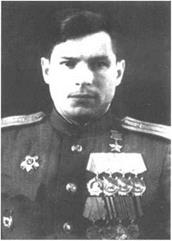
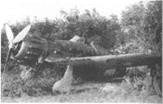

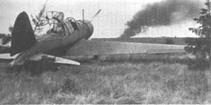
 From our airfield alone we saw twenty-one crash,
From our airfield alone we saw twenty-one crash,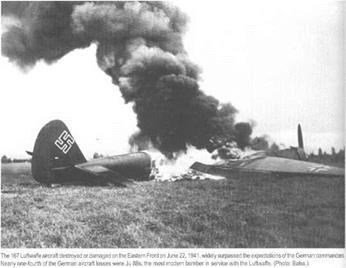

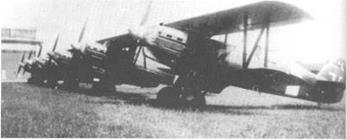
 "lucky guy,” Oberleutnant von Wenchowski, commander of the 5th Staffel, had been killed.”1’
"lucky guy,” Oberleutnant von Wenchowski, commander of the 5th Staffel, had been killed.”1’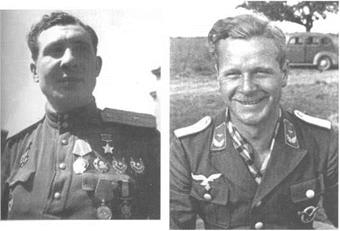 Early on June 23, 1941, Leytenant Andrey Chirkov of 158 IAP was scrambled in a Yak-1 fighter in the Pskov area. He spotted two German bombers flying about a thousand feet higher and attacked from the sun. One of the bombers caught fire from Chirkov’s first burst, and the Soviet fighter plot continued to fire until the enemy plane had descended vertically and crashed into the ground. Chirkov earned a reputation for toughness in the air and considerable flying skills. Although wounded in action twice during 1941, he survived and eventually ran up a score of twenty-nine personal kills and nine shared kills by the end of the war. Chirkov died on Septerroer 10,1956, at the age of thirty-eight. (Photo: Seidl.)
Early on June 23, 1941, Leytenant Andrey Chirkov of 158 IAP was scrambled in a Yak-1 fighter in the Pskov area. He spotted two German bombers flying about a thousand feet higher and attacked from the sun. One of the bombers caught fire from Chirkov’s first burst, and the Soviet fighter plot continued to fire until the enemy plane had descended vertically and crashed into the ground. Chirkov earned a reputation for toughness in the air and considerable flying skills. Although wounded in action twice during 1941, he survived and eventually ran up a score of twenty-nine personal kills and nine shared kills by the end of the war. Chirkov died on Septerroer 10,1956, at the age of thirty-eight. (Photo: Seidl.) attacked friendly bombers. At least four KG 77 Ju 88s and one KG 76 Ju 88 lost on June 23 were shot down by friendly fighters.4 During the late afternoon a Ju 88 fired back, shooting down and killing Unteroffizier Walter Puregger of 5./JG 54.5
attacked friendly bombers. At least four KG 77 Ju 88s and one KG 76 Ju 88 lost on June 23 were shot down by friendly fighters.4 During the late afternoon a Ju 88 fired back, shooting down and killing Unteroffizier Walter Puregger of 5./JG 54.5
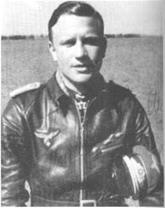
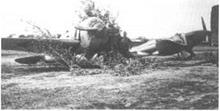
 While the Soviet counterattack in Lithuania finally broke down on June 25, VVS-Northwestern Front attempted a new tactic, concentrating its main bomber forces against the forward German fighter airfields around Vilnius. But the attempt to neutralize the German fighters on the ground backfired cruelly. The vicinity’ of the air base at Vilnius became the scene of another carnage in the air. Throughout June 25, formation after formation of Soviet bombers tried to break through and attack the airfields. Each time, they were bounced by П. and 111./JG 27. One of the German fighter pilots involved in this melee, Leutnant Gustav Langanke, succeeded in shooting down seven bombers. At dusk, the burned-out wrecks of fifty-three DB-3s and SBs—and one Bf 109— surrounded Vilnius.
While the Soviet counterattack in Lithuania finally broke down on June 25, VVS-Northwestern Front attempted a new tactic, concentrating its main bomber forces against the forward German fighter airfields around Vilnius. But the attempt to neutralize the German fighters on the ground backfired cruelly. The vicinity’ of the air base at Vilnius became the scene of another carnage in the air. Throughout June 25, formation after formation of Soviet bombers tried to break through and attack the airfields. Each time, they were bounced by П. and 111./JG 27. One of the German fighter pilots involved in this melee, Leutnant Gustav Langanke, succeeded in shooting down seven bombers. At dusk, the burned-out wrecks of fifty-three DB-3s and SBs—and one Bf 109— surrounded Vilnius.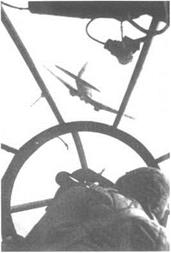
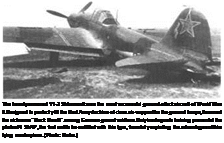 at hand, all manufactured at Aircraft Production Plant No. 18 Znamia Truda at Voronezh. The pilots of 4 ShAP had been shifted from obsolete R-Z planes to Il-2s only in June 1941. By the time the war broke out they had been trained only to take off and land this new aircraft. Knowing nothing about required tactics or combat use, and not even having fired the 20mm guns or RS rockets, they were brought into action against enemy vehicle columns in the Bobruysk area. The first mission was carried out by three Il-2s. One of them returned to base with severe damage from antiaircraft fire. Half an hour later, a damaged SB crashed into this Ilyushin, destroying it completely.15 The next day, the Bf 109s of JG 51 experienced the armored shell of the 11-2 for the first time. Against three of 4 ShAP’s Il-2s that were raiding the pontoon bridges over Berezina River at Bobruysk, the fighter pilots were stunned to see their bullets and cannon shells bounce off the agile single-engine planes. The only result was one damaged 11-2, whose pilot managed to bring it home to a safe landing. During the first three days of combat, 4 ShAP registered only two Il-2s shot down by enemy fighters, but due to a lack of experience among its pilots, a further nineteen were lost to other causes, including at least eight to AAA.14 No less than twenty of the regiment’s pilots were killed or listed as missing during these three days.15
at hand, all manufactured at Aircraft Production Plant No. 18 Znamia Truda at Voronezh. The pilots of 4 ShAP had been shifted from obsolete R-Z planes to Il-2s only in June 1941. By the time the war broke out they had been trained only to take off and land this new aircraft. Knowing nothing about required tactics or combat use, and not even having fired the 20mm guns or RS rockets, they were brought into action against enemy vehicle columns in the Bobruysk area. The first mission was carried out by three Il-2s. One of them returned to base with severe damage from antiaircraft fire. Half an hour later, a damaged SB crashed into this Ilyushin, destroying it completely.15 The next day, the Bf 109s of JG 51 experienced the armored shell of the 11-2 for the first time. Against three of 4 ShAP’s Il-2s that were raiding the pontoon bridges over Berezina River at Bobruysk, the fighter pilots were stunned to see their bullets and cannon shells bounce off the agile single-engine planes. The only result was one damaged 11-2, whose pilot managed to bring it home to a safe landing. During the first three days of combat, 4 ShAP registered only two Il-2s shot down by enemy fighters, but due to a lack of experience among its pilots, a further nineteen were lost to other causes, including at least eight to AAA.14 No less than twenty of the regiment’s pilots were killed or listed as missing during these three days.15